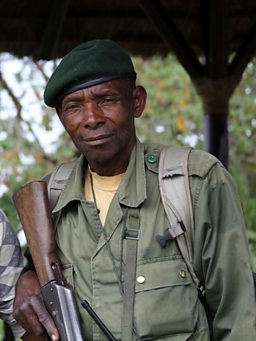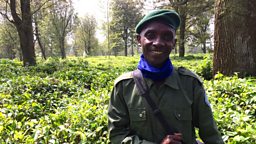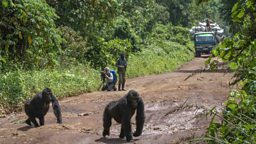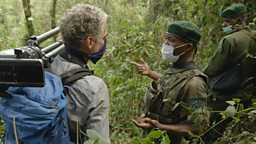Blissful playmates
Neetha Iyer, gorilla reseacrher
When I first began studying Grauer’s gorillas in Kahuzi-Biéga National Park, what struck me most were their eyes. When a gorilla stares back at you, one cannot help but wonder what thoughts lurk behind those warm, brown eyes. Is it recognition? An acknowledgement of our shared ancestry?
When a gorilla stares back at you, one cannot help but wonder what thoughts lurk behind those warm, brown eyes?Neetha Iyer
As a scientist, I try to avoid anthropomorphising and projecting my own emotions when reading animals’ behaviour. And yet I am convinced there is an undeniable, primeval commonness that links us to these great apes. The striking similarity between human and gorilla society is perhaps best exemplified in the boisterous bouts of play amongst gorilla infants.
I have been following silverback Chimanuka’s family for several months, working as a research assistant for Dian Fossey Gorilla Fund International. Every day, the park’s expert gorilla trackers and I head out into the forest to track and observe the habituated group. We often share in the delight of being privy to intimate moments of social grooming and play in the family.
Mwira – the youngest infant in the group – frequently solicits play from any of his siblings who wander close enough, regardless of size or age. His most frequent playmate, Mulenge, is particularly adept at attracting his attention. Only a year or two older, she’s rather competent at what can only be described as “teasing” little Mwira.
On one occasion, while the rest of the family were resting, Mulenge approached Mwira, who was busy testing out his climbing skills on a swinging liana. She clambered quickly up behind him and began wrestling and grabbing at her brother’s feet. Young Mwira, not quite as skilful at maintaining balance, dropped to the ground with a soft plop. Mulenge then proceeded to dangle upside down and wag her tongue back and forth in her gaping mouth.
Undiscouraged, Mwira attempted to climb back up, only to find himself smartly pushed back, by a still upside-down Mulenge. This cycle continued for some time, with Mwira’s determined efforts constantly thwarted by his tongue-wagging sister.
...the complexity of social dynamics in a gorilla family can often mirror that of a human familyNeetha Iyer
After a few minutes, Mulenge seemed to tire of her little brother and scampered off to another more enticing playmate: the mischievous Karibu. The two began to tussle about animatedly, mock-biting and rolling around in unbridled joy. To my surprise, they did not in the slightest disturb their sleeping father, whose colossal frame frequently serves as a backdrop for energetic play sessions.
The young orphaned Marhale, who is often seen sleeping next to Chimanuka, was unperturbed. He rarely plays with the other infants in the family, preferring instead the regular grooming he receives from his doting father.
A large blackback gorilla joined in to play. Tiny Mwira hobbled over to get in on the excitement. That is, until his watchful mother Mwinja detained him. Grabbing hold of one foot, she held him back from what was now a full-fledged wrestling match – clearly too much for the nonetheless eager youngster to handle.
Moments like this help to remind me that the complexity of social dynamics in a gorilla family can often mirror that of a human family. I asked Oscar, one of the Kahuzi-Biéga National Park's trackers, what he would do if one of his children played on his back while he was trying to sleep. He told me he’d probably be happy, because if his kids were playing, that meant they were happy too. I guess there are some things that even years of evolution cannot change.












